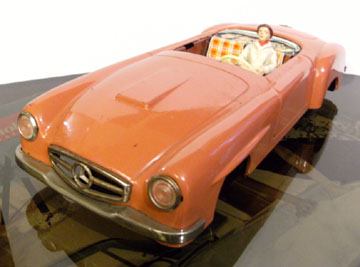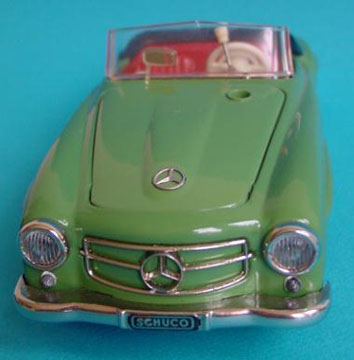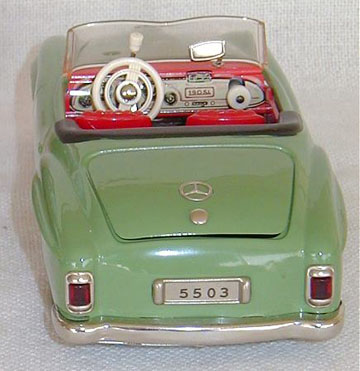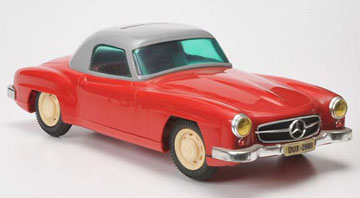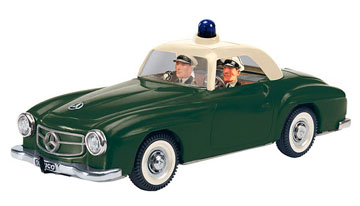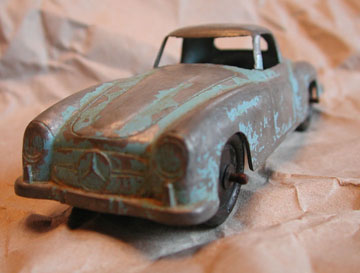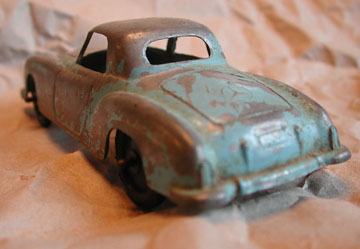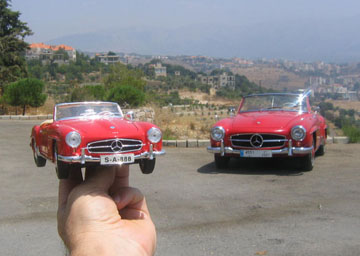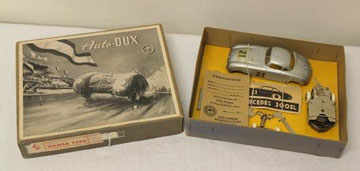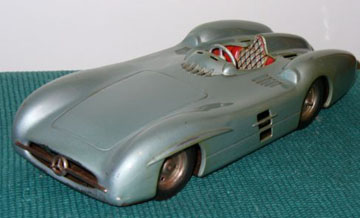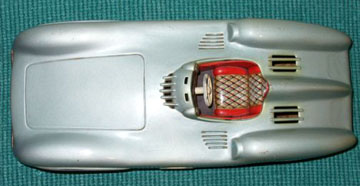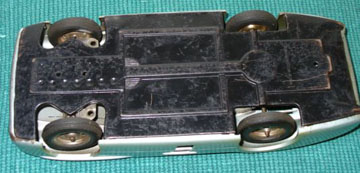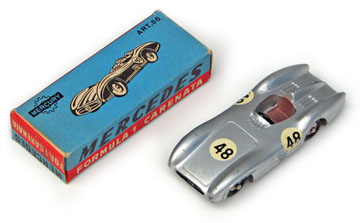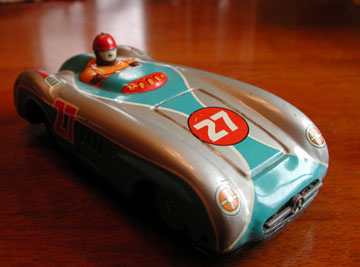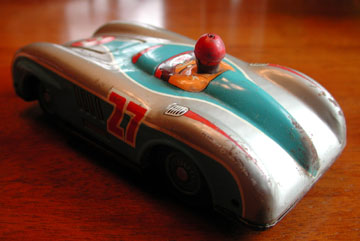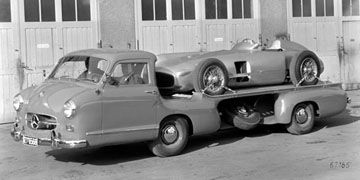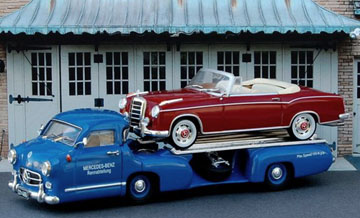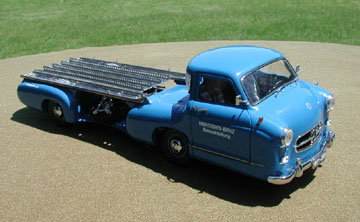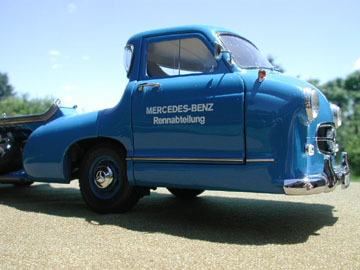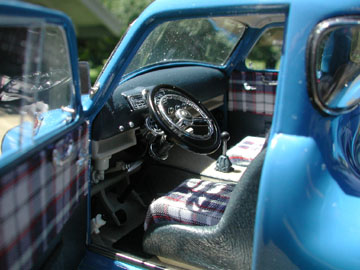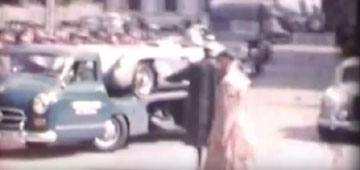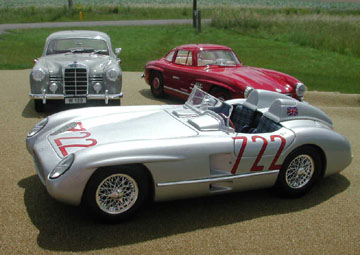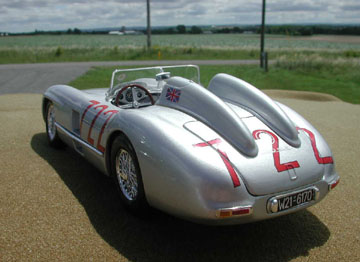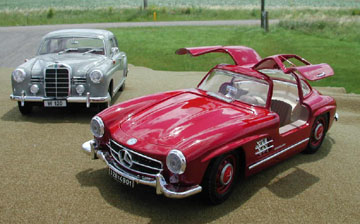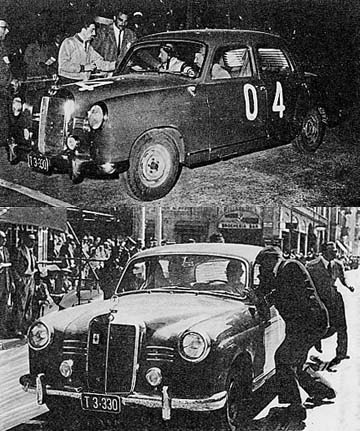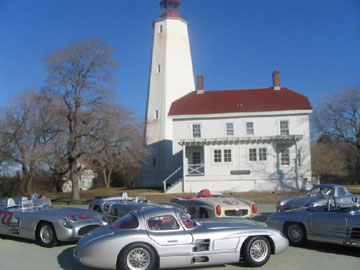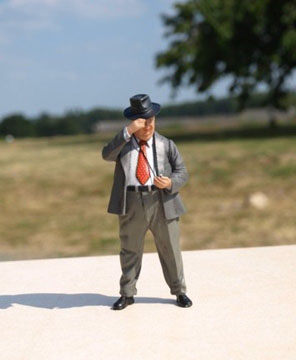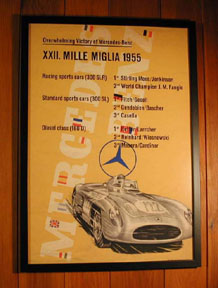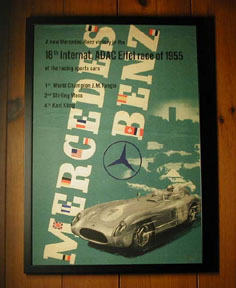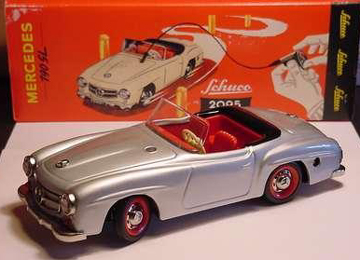
The "SL" is German for "Sport Leicht" (Lightweight Sports)
This was a new model by Schuco (Germany) for 2002. Corresponding to the former "Remote Control Car 2095" this popular car re-appeared in the Schuco range. Partly produced from original tools, the cabriolet features a strong spring drive, an automatic stop lever and a remote control device. This is a large (25 cm long) clockwork driven toy that runs only when the car is on the ground. It has a steering control cable, and the set comes with posts to maneuver the car around. Completely new toy in box with key. Comes in a nice lithograph presentation box.
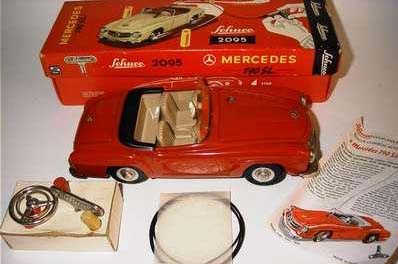
Schuco "Remote Control Car 2095." Tinplate 1:18 scale replica of the Type 190SL roadster-cabriolet. Features a wind up clockwork motor and "remote control" steering (via cable). The kit also includes yellow and red pylons so navigational skills can be tested on the "KFG" (Kitchen Floor Gymkhana).
Mercedes-Benz Type 190SL roadster / Manufactured by Michael Seidel (Western Germany)
Photo courtesy: Jean Luc Laubreton / France / November 18, 2010
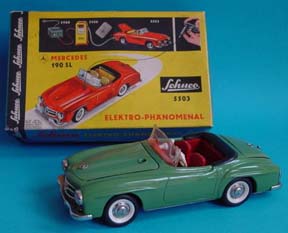
190SL / Schuco № 5503 "Elektro-Phänomenal" remote control / tinplate
Schuco (Germany) № 5503 tinplate model of Mercedes-Benz Type 190SL roadster
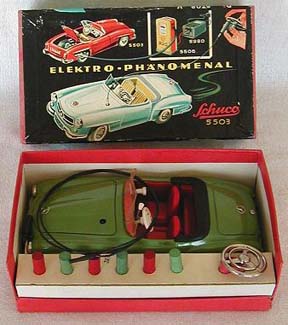
This is a battery powered tin toy from the Schuco factory in Western Germany. The Schuco № 5503 model was produced between 1955 and 1969. The gearshift has a forward, neutral and a reverse position.
Type 190SL by DUX
Schuco № 5509 / Mercedes-Benz Type 190SL Police Car. Radio squad car with electric motor and electric rotating flashing light. The electric rotating flashing light can be operated independently from the drive mode. When the light is switched on, the passenger lifts and lowers the microphone. Available new in 2008 for about $125 USD.
Schuco Motex № 1088 / Mercedes-Benz Type 190SL. Tinplate body. The model is activated by a frictional wheel which touches the ground. By pressing lightly on the car and pushing it forward hard, it will speed away immediately when released. The direction of travel can be set on the lever on the number plate. Production of the original version began in 1962. Available new in 2008 for about $150 USD.
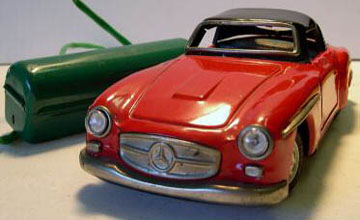
Battery powered tinplate Type 190SL coupé / Manufacturer unknown
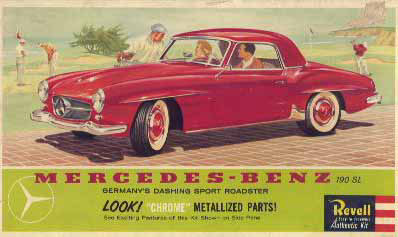
Tootsietoy (Chicago, Illinois) Mercedes-Benz Type 190SL
Rough paintwork, but otherwise intact
Photos Courtesy: Jeff Miller / December 26, 2009
1955 190SL by Maisto (1:18 scale) with a 1961 Mercedes-Benz Type 190SL prototype (full scale) in the background.
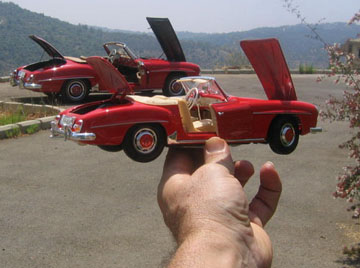
The Maisto model is die-cast metal with plastic trim elements. Very detailed and realistic as these photos illustrate.
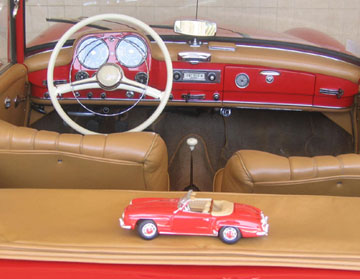
Owner of both cars: Farouk El-Khalil / Beirut, Lebanon
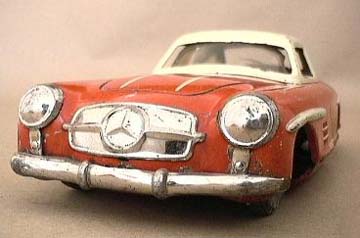
This is Tipp & Co. № TCO 956. Mercedes-Benz Type (W198 I) 300SL "Gullwing" coupé. Made in Germany by Tipp & Co (TCO) — one of the largest manufacturers of tin toys in Nürnberg, Germany after 1922.
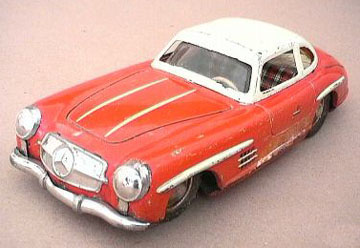
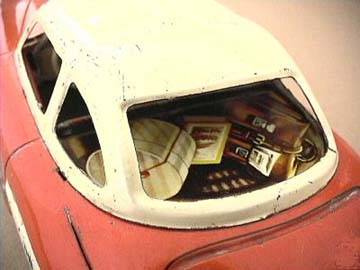
In less than perfect condition, this example still exudes a lot of charm. The tinplate lithography includes details such as the personal effects on the rear parcel shelf. Note the round, hat box—I remember them, but many readers may not. The wide parcel shelf is a feature the TCO toy company fabricated itself. The real 300SL had a stowage area behind the seats.
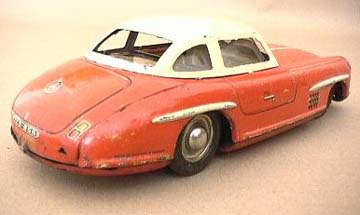
Missing the rear bumper, this would still be a nice addition to any vintage Mercedes-Benz tinplate model collection.

Undercarriage of the Tipp & Co. № TCO 956

Type (W198 II) 300SL roadster. The full scale roadster was in production from 8/57 - 2/63. This is a tinplate, remote control, battery operated model with original packaging. Manufacturer unknown.
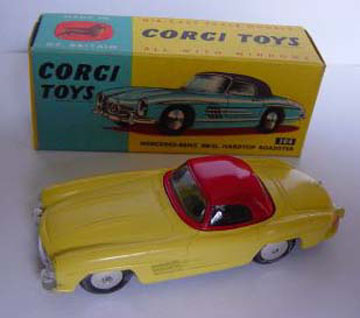
Corgi (England) № 304 die-cast model (1:43 scale) of the Mercedes-Benz Type (W198 II) 300SL roadster

A rare 1:43 scale tinplate, wind-up model of the famous 1952 Mercedes-Benz Type W194 300SL pre-production prototype. The toy was produced in Germany by "Dux" (Auto-Dux series). The W194 300SL was the genesis of the "sport leicht" (SL / lightweight sports) automotive institution, which continues today.
Dux was the toy label name for the German firm, Markes & Co. The company was founded in 1904 by Karl Markes in Lüdenscheid. From the 1930s, Dux production evolved into tin model car kits. Production changed over to plastic in the 1960s. Toy production ceased altogether in 1981. At the 1953 Nuremberg Toy Fair, Markes & Co. of Lüdenscheid introduced the first Dux 300SL miniature. It was made entirely of tin, and silver colored like the prototype. With a length of 12 cm, it was not exactly enormous, but featured a number of smart details. The model was constructed so that the young owner could remove the body from the chassis by using the tools included (wrench and screw driver). This was usually not possible with classic tin toys due to the typical slot and tab construction. In addition, it was possible to remove the series standard clockwork motor and exchange it for one (available as an accessory) with flywheel drive. So, not only a very attractive and thoughtfully designed model, but also one of high educational value. This Dux classic was in their program from 1953 until 1958.
References
Mercedes Sportscar Scale Models / Matthias Braun / ISBN: 3-89365-703-7
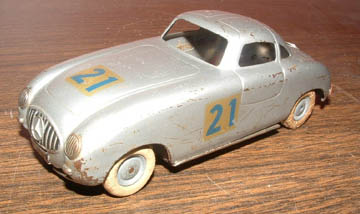
This one suffered minor paint damage, but is still a visual treat. Note the white tires on this example.
These models are quite rare today, especially in above-average condition. Prices for scratched examples (missing wheels, etc.) can range from $30-$75 (circa 2006) depending on overall condition.

Doors of this type (shown on the Dux model) were used at the Le Mans race on June 14-15, 1952. Previously, (for the Mille Miglia race in May 1952) the doors only extended to the base of the windows. The driver's entry point was more like a "hatch" than a door. The organizers of Le Mans had more stringent regulations, which forced the designers make the door openings descend lower into the body of the car. The grille shape was derived from the 1939 Grand Prix cars. The 1952 300SL (W194) would have used three downdraft Solex carburetors, while the production models, the 300SL coupé (W198 I) and later, the 300SL roadster (W198 II) both used Bosch mechanical fuel injection.
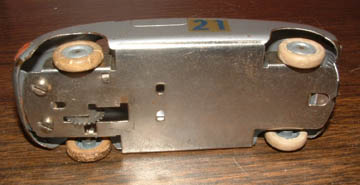
1952 Mercedes-Benz Type W194 300SL by Dux. Note the smooth undercarriage. On another example (see below) the name DUX is clearly visible.

Note the name "DUX", and the altogether different base plate configuration on this example. Finding both base plate variations will keep the average collector out of trouble for a while.
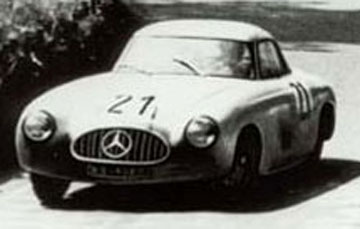
For Reference: The full scale Type W194 300SL ("21") at Le Mans on June 14-15, 1952 (Sarthe, France). Only the top lines of the car were retained when the W194 SL was modified for production. This is clearly the car the Dux (Auto-Dux) tinplate model represents, as verified by the number "21" on the hood and doors. Number 21 took first place in the race, and driving was shared between Hermann Lang and Fritz Riess. The 24 hour race of endurance was 2,320 miles (277 laps). Average speed 96.6 km/h (60 mph).

Type W194 300SL racers at the Nürburgring, competing in the Eifel race on August 2, 1952. The lightest possible autos were necessary, so the tops of the 300SLs were cut off. Note number 21 in the center.
Based on the open-wheeled version of the 1954-55 Mercedes-Benz Type W196R Grand Prix racer. The driver is not original to the model. Click on the image for more detail.
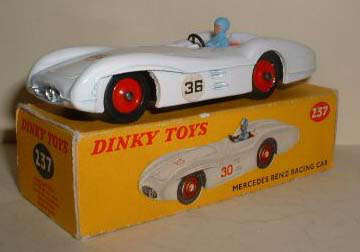
Type W196S (streamliner) with original box. Made by Dinky (№ 237 in the Dinky series). Note the decal ("36") on the side. The box shows number "30."
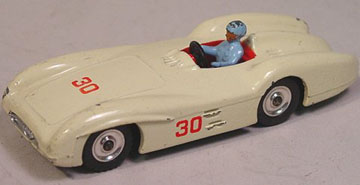
Type W196S (streamliner). Made by Dinky (№ 237 in the Dinky series). This model has number "30" on the sides and the engine hood. Variations of this British-made toy include red or chrome wheels, and either white or off-white paint.
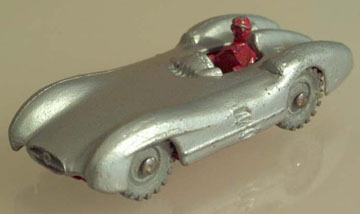
Budgie (UK) № 7 – Type W196S streamliner. die-cast, approximately 1:65 scale. In reality, the streamliner W196S Mercedes-Benz made its debut at Rheims in the July 4, 1954 French Grand Prix. The race was won by Juan Manuel Fangio in the number 18 streamline-bodied W196S.
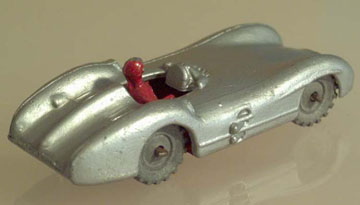
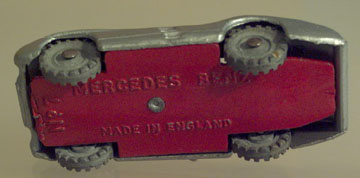
Budgie № 7 in the miniature die-cast series
Tinplate Mercedes-Benz W196S streamliner. Made in West Germany.
Features a friction motor, and the steering wheel operates the front wheels.
Originally, it had a small plastic windscreen which fitted into the slots on the dash cowl
Photos courtesy: Paul Mcleod / Australia / November 21, 2008
Mercedes-Benz Type W196S 1:60 scale die-cast streamliner
Made by Mercury (Italy) in 1958. Art.56 (Article 56) / Mercedes Formula 1 Carenata
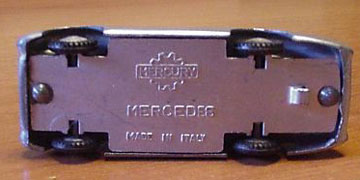
Carenata means "bodied with wheels covered" (i.e. streamlined) as opposed to the open wheeled Grand Prix style bodies.
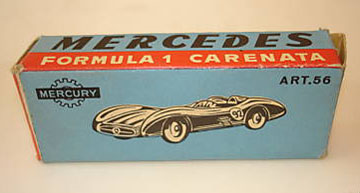
The box shows number 92 on the body but the model itself is identified as "48."
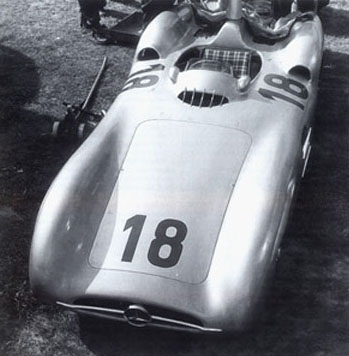
This is the Type W196S driven by Juan Manuel Fangio at the French Grand Prix in Reims, July 4, 1954. Fangio won the race, and second place was also a W196S driven by Karl Kling (number 20). Hans Herrmann started in number 22.
Tinplate (unknown manufacturer – probably Japanese) Mercedes-Benz 300SLR (W196S) "streamliner" racer. Nice litho artwork including driver with separate, swiveling head. Rubber tires. Length: 150 mm (6"). Length of prototype was 4300 mm, so scale of this example was calculated to be ~1/28.
Photos courtesy: Jeff Miller / February 11, 2012
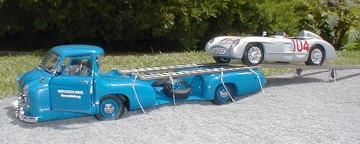
In this photo, Graham van Heerden (Cape Town, South Africa) displays the CMC (Germany) 1:18 scale 1954 Mercedes-Benz Race Transporter with a model 300SLR (number 104 / Targa Florio) being loaded.
In 2002, the German concern CMC released this highly detailed 1:18 scale die-cast replica of the 1954 Type W21 Mercedes-Benz "Silver Arrow" Renntransporter (race transporter). The CMC catalog number was M-036. Silver Arrows (in German: "Silberpfeile") was the name given by the press to Germany's dominant Mercedes-Benz and Auto Union Grand Prix racing cars between 1934 and 1939, and also later applied to the Mercedes-Benz Formula One and sports cars in 1954 and 1955.
The Renntransporter prototype included certain Ponton parts such as the cabin of a Type 180 sedan (modified to be a bit wider), headlights, doors, turn signals and more. The chassis of the original was from a Type W188 300S.
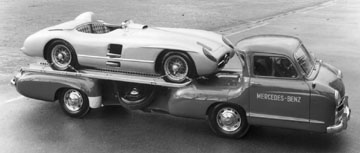
Surprisingly, the original Mercedes-Benz Renntransporter (shown here) was dismantled and scrapped by Daimler-Benz in 1967.
Technical Data of the Original Race Transporter
• In-line 6-cylinder engine (from 300SL) • Mechanical fuel injection • Maximum output: 192 hp at 5,500 rpm • Displacement: 2,996 cc • Top speed: 170 km/h (105 mph) • Wheel Base: 3,050 mm • Length: 6,750 mm • Width: 2,000 mm • Total weight: 2,100 kg (4,629 lbs)

The original Renntransporter (date unknown) with Mercedes-Benz works driver Karl Kling (right) and a W196R Formula One racing car on the bed. Note Kling's signature near his feet. Kling (1910-2003) was instrumental in developing the return of Mercedes-Benz to international competition in the early 1950s. His win in the 1952 Carrera Panamericana road race, driving the experimental Mercedes-Benz 300SL (W194) was a defining point in assuring the Daimler-Benz management that motorsport had a place in their future.
The original Renntransporter (date unknown) with a W196R Formula One race car. Photo: DBAG
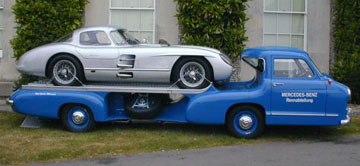
In the late 1990s, DaimlerChrysler decided to build a new full scale transporter. They had to use archive photographs of the original because all of the blueprints and drawings were unavailable. The original used a de-tuned (198 bhp) 3 liter in-line 6 cylinder engine from the Type 300SL "Gullwing" coupé, which was able to propel the transporter to 170 km/h (105 mph). The photo above shows the full scale reproduction Type W21 transporter as it appeared at the Goodwood Festival of Speed (UK) on July 8, 2001. It includes the Type 300SLR "Uhlenhaut" coupé. Photo courtesy: Mark Gussin.
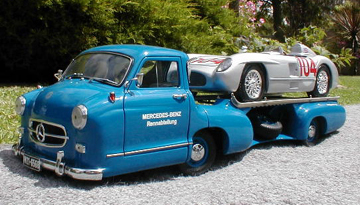
Back to the 1:18 scale model again. The W21 transporter and the W196 "Silver Arrow" race car were sold as individual pieces by CMC. The models are quite detailed and true to the originals. The doors are inscribed with, "Mercedes-Benz Rennabteilung." The rear fenders are inscribed with, "Max. Speed 105 m.p.h.." The license tags are inscribed with, "W21-6568." Photo of the CMC model M-036 courtesy: Graham van Heerden / Cape Town, South Africa / November 28, 2003
Mercedes-Benz race transporter by Premium ClassiXX with die-cast model of Type 220SE Ponton cabriolet by IXO – both 1:43 scale. Photo courtesy: Tom Gibson / Anderson, South Carolina / November 30, 2008
1954 Mercedes-Benz Renntransporter by CMC GmbH. Die-cast, 1:18 scale, Item No M-036. Serial number: 16399. This example was a gift to the editor from Larry Hansen. Photo: Jeff Miller / Nikon Coolpix 990 / July 5, 2009
1954 Mercedes-Benz Renntransporter by CMC GmbH. Die-cast, 1:18 scale, Item No M-036. Serial number: 16399. Photo: Jeff Miller / July 5, 2009
Interior of the 1954 Mercedes-Benz Renntransporter by CMC GmbH. Die-cast, 1:18 scale, Item No M-036. Serial number: 16399. Photo: Jeff Miller / July 5, 2009
Top view of 1954 Mercedes-Benz Renntransporter by CMC GmbH. Die-cast, 1:18 scale, Item No M-036. Serial number: 16399. Photo: Jeff Miller / July 5, 2009

Detail of the full-scale reproduction Mercedes-Benz Renntransporter at the
Goodwood Festival of Speed (UK) / 2013
Photo: Dean Blackwell, M.D. / Jackson,
Mississippi
The original Renntransporter at the infamous 24 Hour Le Mans race / June 11, 1955
Infamous 1955 Le Mans Crash
The tragic events of the 1955 24 hour Le Mans race caused Mercedes-Benz to withdraw from racing for over 30 years. Mike Hawthorn (British, aged 26, driving a D-Type Jaguar) had just passed (lapped) Lance Macklin (British, aged 35, driving an Austin Healy 100S). As soon as Hawthorn got directly in front of Macklin, he began slowing to make a pit stop. Macklin was forced to brake hard to avoid rear-ending Hawthorn, causing him to swerve (momentarily losing control) and ultimately cross beyond the center lane – into the left lane and the oncoming path of Pierre Levegh's Mercedes 300SLR, which was just ahead of the team's number one Mercedes – driven by Juan Manuel Fangio. Levegh had no time to react. There were 83 people killed and hundreds injured when Levegh's car (number 20) hit the left rear corner of Macklin's Healey while going 150 m.p.h. In an instant, the impact caused the ill-fated Mercedes to launch off the track and land on a five-foot-high earthen barrier, where it flipped end-over-end, and burst into flames as the engine, front suspension, and other debris cut a devastating path through the packed grand stands. Mercedes-Benz driver Pierre Levegh (French / aged 49) was thrown from the car (seat belts were not used) and killed instantly. The race continued another eight hours before Mercedes, wishing to avoid a public relations fiasco, withdrew from the race. Jaguar was invited to do the same, but declined. Lance Macklin was uninjured, but his car was totaled, and Mike Hawthorn went on to win the race.
Epilogue
Mike Hawthorn died in 1959 at age 29 in a car accident on the notoriously dangerous A3 Guilford bypass while driving his modified 1958 Jaguar 3.4 Mk 1 saloon over 80 m.p.h – just after overtaking a new Mercedes-Benz 300SL convertible driven by motor racing team manager acquaintance Rob Walker. He clipped a "Keep Left" bollard causing him to lose control. He then glanced the rear fender of an oncoming Bedford lorry, and finally careened sideways across the eastbound carriageway and uprooted a 22 cm (9") diameter, roadside tree. Lance Macklin died in 2002 at the age of 83.
Sources
- Kahn, Mark. Death Race Le Mans 1955. London: Barrie & Jenkins Limited, 1976. Print.
- BBC. Deadliest Crash the 1955 Le Mans Disaster. Bigger Picture Films. Catalogue № BIGPDVD7. Release Date: December 14, 2009. DVD video.
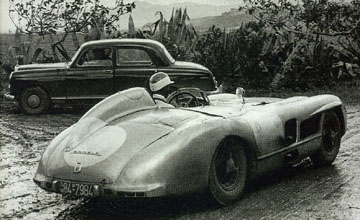
American race car driver John Fitch at the wheel of the four cylinder Ponton sedan
with (presumably) Juan Manuel Fangio in the 300SLR
Photo uploaded October 2, 2015 / Road & Track / December 2012
Another arrangement of Larry Hansen's impressive model collection. Even though the 300SLR is the only exact replica from the 1955 Mille Miglia (1,000 mile open-road race), all three of these Mercedes-Benz vehicles were champions in their respective classes in the race. Foreground: 1:18 scale version of the W196S 300SLR Streamliner (Racing Sports Car Class), overall winner of the race. The driver was Sterling Moss and his navigator was Denis Jenkinson. The pair won the race in 10 hours, 7 minutes, and 48 seconds, at an average speed of 97.96 mph, a record which was never broken. Incidentally, Sterling Moss practiced the race course in a Type W180 220a Ponton sedan before he was allowed to drive the 300SLR on the Italian roads. After the initial familiarization and testing period, when he took the 300SLR on the roads, Mercedes-Benz racing manager Alfred Neubauer said the speed was to be kept under 170 miles per hour and night driving was forbidden!
In the background, we see the Revell 1:18 scale Type 180 Ponton sedan, and a 1:18 scale 300SL Gullwing coupé. A black 300SL Gullwing (number "417", departed the Mille Miglia start line at 04:17) driven by American John Fitch with German journalist-cum-navigator Kurt Gesell won the Gran Turismo class.
Number 722 signifies the time of the morning on May 1, 1955 that Sterling Moss and Denis Jenkinson started the race. Photo of Larry Hansen's collection courtesy: Jeff Miller / Nikon Coolpix 990 / July 2, 2005
Revell 1:18 scale Type 180 Ponton sedan, and a 1:18 scale 300SL Gullwing coupé
Mercedes-Benz Type 300SL Gullwing coupé along side the Revell 1:18 scale Type 180 Ponton sedan. Two opposite ends of the spectrum in terms of models offered by Daimler-Benz in 1954. If your budget prevented you from owning the 300SL dream car, the Type 180 was a more affordable entry point into the family of Mercedes-Benz passenger vehicles. Photo of Larry Hansen's collection courtesy: Jeff Miller / Nikon Coolpix 990 / July 2, 2005
Two photos of the "04" 180D in the 1955 Mille Miglia
Finally, the Type 180D Ponton sedan (40 bhp), driven by Helmut Retter and navigated by Wolfgang Larcher, won the Diesel Class of the historic 1,000 mile Italian race (coming in 201st overall) at an average speed of 58.81 mph. The diesel sedan left the start point (Brescia) at 00:04 a.m., and thus had the number "04" on the doors. The light colored car (a dullish gray*) had round fog lights, no hubcaps, and louvered blinds in the rear window. Photos of the 180D Mille Miglia Ponton courtesy: Larry Hansen / July 15, 2005
*A reader of this page contacted the editor on March 29, 2008, and reported that the color of the "04" 180D is "dullish gray", and is still the same color after all these years, and has not been resprayed. In 2008, it was in the Mercedes-Benz Museum in Stuttgart.
Gathering of 1:18 scale Mercedes-Benz racers with the lighthouse at Sandy Hook, New Jersey in the background. Photo courtesy: Rich Sufficool / Camera: Canon PowerShot S3 IS / August 11, 2009
Mercedes-Benz Grand Prix race manager
Alfred Neubauer (1891-1980) in 1:18 scale by LeMans Miniatures
Photo uploaded October 25,
2014
Mercedes-Benz Victory Posters
The famous 1955 Mille Miglia (April 30 / May 1) and the May 29, 1955 ADAC-sponsored Eifel race
(Nürburgring)
These posters feature the victorious 1955 Mercedes-Benz W196S 300SLR "streamliner" race cars. Original victory posters were about 23 x 25 cm (9" x 10"). These were enlarged to 43 x 61 cm (17" x 24") not including the frames.
The Mille Miglia poster is historically incorrect for the following reasons: It is shown as having only one driver, but the race was actually won by Stirling Moss and his navigator, Denis Jenkinson. Also, the number 722 did not have a white field (circle) behind it. Perhaps the organizers predicted that Fangio would win, and the victory posters were printed with the likeness of his car.
Mercedes-Benz Pontonobilia
Created: June 20, 2001 / Jeff Miller
Last Update: March 14, 2019
© www.mbzponton.org
Return to the Ponton Photo Gallery
Return to the Pontonobilia page
